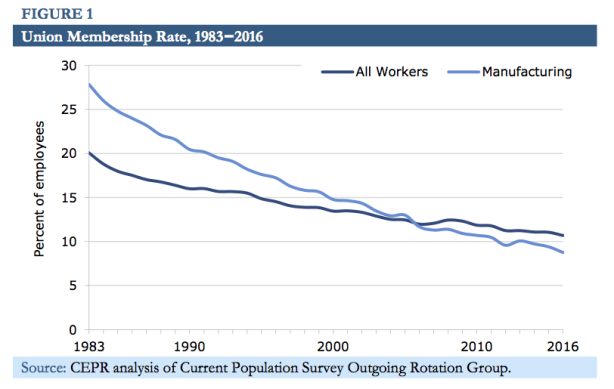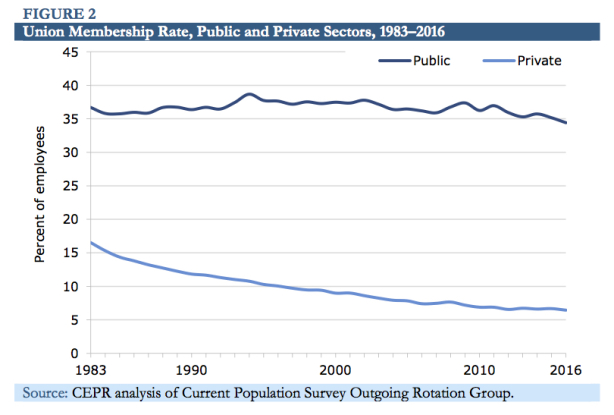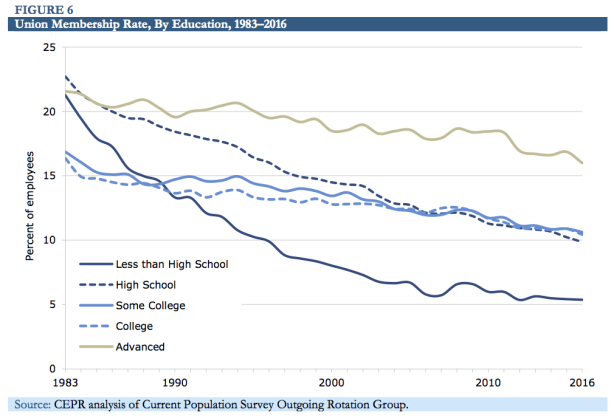From David Ruccio source (pdf) The share of American workers in unions fell to 10.7 percent in 2016 (down from 11.1 percent in 2015), the lowest level on record, according to the Bureau of Labor Statistics (pdf). What we’re seeing is a return to the downward trend for organized labor after membership figures had stabilized in recent years—and this is before the new Republican administration even took office. source (pdf) Union membership in the private sector fell by 119 thousand and the membership rate fell 0.3 percentage point to 6.4 percent. There was a slightly larger decrease in union membership in the public sector (down 121 thousand), corresponding to a 0.8 percentage-point drop in the public sector membership rate to 34.4 percent. Although public sector workers are more likely than their private sector counterparts to be union members, there are still more private-sector union members (7.4 million) than public-sector union members (7.1 million). That’s because public-sector workers account for only about 15 percent of the workforce. Addendum source (pdf) The Bureau of Labor Statistics does not publish union data by education level. However, according to the Center for Economic and Policy Research (pdf), union membership rates rise as education level increases therefore workers with an advanced degree are the most likely to be union members.
Topics:
David F. Ruccio considers the following as important: Uncategorized
This could be interesting, too:
tom writes The Ukraine war and Europe’s deepening march of folly
Stavros Mavroudeas writes CfP of Marxist Macroeconomic Modelling workgroup – 18th WAPE Forum, Istanbul August 6-8, 2025
Lars Pålsson Syll writes The pretence-of-knowledge syndrome
Dean Baker writes Crypto and Donald Trump’s strategic baseball card reserve
from David Ruccio

source (pdf)
The share of American workers in unions fell to 10.7 percent in 2016 (down from 11.1 percent in 2015), the lowest level on record, according to the Bureau of Labor Statistics (pdf).
What we’re seeing is a return to the downward trend for organized labor after membership figures had stabilized in recent years—and this is before the new Republican administration even took office.

source (pdf)
Union membership in the private sector fell by 119 thousand and the membership rate fell 0.3 percentage point to 6.4 percent. There was a slightly larger decrease in union membership in the public sector (down 121 thousand), corresponding to a 0.8 percentage-point drop in the public sector membership rate to 34.4 percent.
Although public sector workers are more likely than their private sector counterparts to be union members, there are still more private-sector union members (7.4 million) than public-sector union members (7.1 million). That’s because public-sector workers account for only about 15 percent of the workforce.
Addendum

source (pdf)
The Bureau of Labor Statistics does not publish union data by education level. However, according to the Center for Economic and Policy Research (pdf), union membership rates rise as education level increases
therefore workers with an advanced degree are the most likely to be union members. In 2016, their membership rate decreased 0.9 percentage point to 16.0 percent. The membership rate for workers with a bachelor’s degree fell 0.5 percentage point to 10.4 percent. Workers with some college but no degree and those with a high school degree all saw their membership rates decrease 0.3 percentage point to 10.6 percent and 9.9 percent, respectively. Workers with less than a high school degree had a union membership rate of 5.4 percent in 2016, the same as in 2015.
